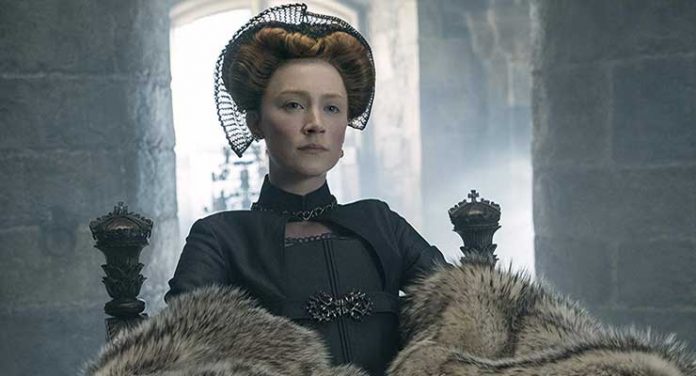
Mary Stuart (Saiorse Ronan) went to France as a young girl, married King Francis II at sixteen, was widowed at eighteen, and, the following year, returned to her native Scotland as a total stranger. Mary’s being a Catholic during a period of Protestant ascendance continually threatened her reign. When populist cleric John Knox (David Tennant) publicly criticizes her religion and her morals, the lines at Holyrood Castle are clearly drawn. Mary’s half-brother James, Earl of Moray (James McArdle) initially supports her but later becomes her adversary, due in part to his disagreement with her advisor Lord Bothwell (Martin Compton).
Henry VIII’s Third Succession Act forbade any Stuart offspring from attaining the throne of England. This led to growing tension between Queen Elizabeth I (Margot Robbie), the late monarch’s illegitimate and childless daughter, and Mary, the second cousin whom she had never met. Following Lord Cecil’s (Guy Pearce) advice, Elizabeth sends her favorite, Robert Dudley (Joe Alwyn), to wed Scotland’s queen but he is supplanted by Mary’s English cousin Lord Darnley (Jack Lowden). Darnley, a sot and a sodomite, is an embarrassment to a crown that he will never wear but a stud that manages to impregnate Mary who bears him a son, James, the future ruler of both England and Scotland.
Following several attempts to remove Mary from her throne, Darnley is assassinated by Bothwell who briefly becomes her third husband. The dramatic apex of Mary Queen of Scots occurs during the film’s final fifteen minutes when the two queens meet for the first time in a humble English laundry shed. The “sisters,” as they refer to each other, are visually separated by hanging bed sheets, as Elizabeth, wearing white make-up and orange wig to conceal the ravages of smallpox, concedes the superiority of her rival but will never air this personal admission in public. Once Mary abdicates her throne, Elizabeth’s promise of “protection” is virtual house arrest until her execution, some two decades later.
[envira-album id=”115697″]
Saoirse Ronan, a previous Academy Award nominee, should receive another Oscar bid for her terrific turn as the resourceful young queen to whom she bears a striking resemblance. Another former Oscar nominee, Margot Robbie, undergoes an astonishing physical transformation into Elizabeth Regina and, during her relatively brief time on the screen, masterfully portrays an angst-ridden monarch whose claim to England’s throne was challenged by her cousin whom many believed to be the rightful heir. The British supporting cast led by Guy Pearce, David Tennant, Jack Lowden, and James McArdle all provide excellent realizations of their historical roles. The only non-Brit, Ismael Cruz Cordova, adds a sympathetic character to this rather somber ensemble as Mary’s ill-fated courtier, David Rizzio, whose brutal murder contributes to the film’s “R” rating.
The Achilles’s heel of this visually stunning film, endowed with John Mathieson’s sweeping views of the Scottish countryside, is its slowly paced and often confusing script. Beau Willimon’s (House of Cards) overly ambitious storyline presents an often-dizzying array of interpersonal relationships, court intrigues, and dramatic moments that will befuddle those unfamiliar with the history of Mary’s brief reign. On a more positive note, composer Max Richter has penned a haunting score while famed English stage director Josie Rourke consistently stimulates her cast to become real flesh-and-blood characters.
There have been several previous films with starrier casts about the last Catholic monarch of Scotland but this Mary Queen of Scots is the only one in which both actresses are nearly the same ages as the queens that they portray making the fictionalized depiction of their regal confrontation all the more credible. Script and pacing issues aside, this one is still quite worth taking in for the outstanding performances of its two female leads and its stunning recreation of a slice of English history that permanently impacted this nation’s future course.
Mary, Queen of Scots is in wide release in theaters December 21, 2018 (USA)
[youtube httpss://www.youtube.com/watch?v=wnqjSgMU36U&w=790&h=444]
Be the first to leave a review.

